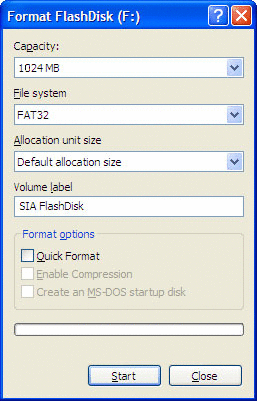

After you have booted into the bootable USB Secure Erase tool you will see a list of all drives identified by the model number and to the left will be the name of the drive as identified by the Secure Erase tool.Ĥ. Connect a USB drive and select that USB drive (all data on the USB drive will be destroyed so ensure no important data is on the USB drive)ģ. In the SSD Dashboard first select the Tools tab and then on the left side select Secure EraseĢ. Type N to exit the sanitize tool reboot the computer.ġ. Once the drive is selected type Y to confirm and press enter Once you have booted into the bootable USB sanitize tool you will see a list of all drives identified by the model number and to the left will be the name of the drive as identified by the sanitize tool.Įnter the Device name (indicated above by the red circle) of the drive you want to sanitize
#Secure erase usb flash drive how to
Refer to your computer documentation for instructions on how to boot from a USB drive Once the Bootable USB drive has been create Restart your computer and select to Boot from the USB drive (all data on the USB drive will be destroyed so ensure no important data is on the USB drive) Primary Drive: If the SSD is the system/boot drive (C: drive) you will need to choose Create USB Drive to create a bootable USB drive that can be used to sanitize the SSD Secondary drive: If the SSD is not the system/boot drive (C: drive) you can simply select Erase now and follow the prompts to sanitize the SSD.Ģb. In the SSD Dashboard first select the Tools tab and then on the left side select SanitizeĢa.

Refer to the SanDisk SSD Dashboard to see if your SanDisk SSD support Sanitizeġ. NOTE: Not all SanDisk SSD support Sanitize. TrueCrypt is free, strong, and easy to use. Then make your case for remote USB wipe.Secure Erase and Sanitize both securely erase all user data and reset the SSD to out of box performance I would suggest starting with using strong encryption on your USB devices. If your users need to use the device when they don't have a connection, they won't be able to use a 'phone home before decrypting' scheme. So you'll want to have the contents encrypted first, to prevent mining the data on a device that's kept offline.

Good enough for us.Īny remote wipe scheme is going to have to involve some way for the USB device to connect to the internet and get a remote wipe signal. So while we can't remote wipe them, they have strong encryption, and if someone tries to crack the password, it bricks itself.
#Secure erase usb flash drive password
But there is still the 2nd level of protection - the encrypted IronKey can be set to self-destruct its memory chip after X failed password attempts. We have folks in the field without connections quite often, so we can't use this feature. This means that if the user doesn't have an active internet connection, there is no way to get to the files on the IronKey. You can set them up so that they can be remotely wiped, but in order for this feature to function, it has to phone home for either the OK or remote wipe signal before you can unlock (decrypt) its contents. The IronKey (we use them in our enterprise) has two levels of protection. A laptop with Prey or LoJack or similar products can similarly just be kept off the internet until it's been mined and reset the only way it can be tracked or remote wiped is by contacting the mothership via the internet, so a smart crook would just keep it offline. In the smartphone example, a thief would simply put it in Airplane Mode until they've mined all the data from the device. On an IronKey, you can set it to phone home before unlocking (decrypting) for either an authentication or remote wipe signal. On a smartphone/tablet using ActiveSync, when it tries to sync with the Exchange server, you can tell the device 'no mail for you, do a factory reset on yourself instead'. In order to do remote wipe on any device, the device has to 'phone home' to get the wipe signal.


 0 kommentar(er)
0 kommentar(er)
